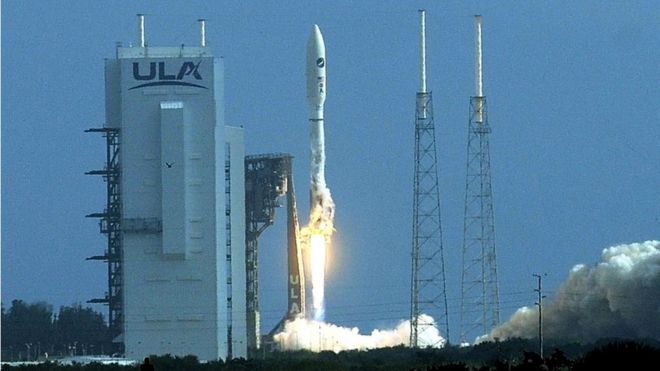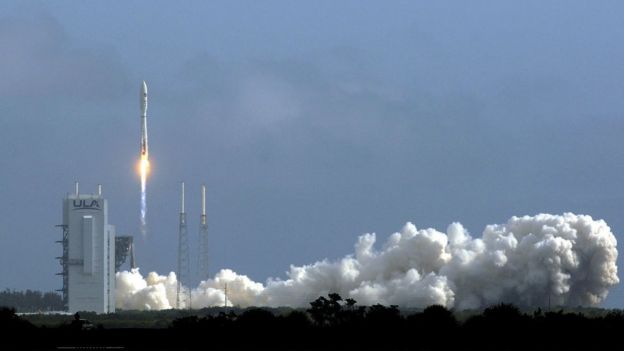Space Plane: Mysterious US military aircraft launches
 GETTY IMAGES
GETTY IMAGES
The US Air Force has successfully launched its Atlas V rocket, carrying a X-37B space plane for a secretive mission.
The rocket launched on Sunday from Cape Canaveral, a day after bad weather halted plans for a Saturday launch.
The aircraft, also known as an Orbital Test Vehicle (OTV), will deploy a satellite into orbit and also test power-beaming technology.
It is the plane's sixth mission in space.
The launch was dedicated to front line workers and those affected by the pandemic. A message including the words "America Strong" was written on the rocket's payload fairing.
X-37B is a classified programme and very little is known about it. The Pentagon has revealed very few details about the drone's missions and capabilities in the past.
"This X-37B mission will host more experiments than any other prior missions," Secretary of the Air Force Barbara Barrett said earlier this month.
One of the experiments will test the effect of radiation on seeds and other materials.
 GETTY IMAGES
GETTY IMAGES
The X-37B programme started in 1999. The aircraft resembles a smaller version of the manned space shuttles that were retired by the US space programme in 2011. It can glide back down through the atmosphere to land on a runway, just as the shuttle did.
Built by Boeing, the plane uses solar panels for power in orbit, measures over 29ft (9m) long, has a wingspan of nearly 15ft and a weight of 11,000lbs (4,989 kg).
The first plane flew in April 2010 and returned after an eight-month mission
The most recent mission ended in October 2019, after 780 days in orbit, bringing the aircraft's time in space to more than seven years.
The length of this mission is currently unclear.
Boeing-built X-37B Launches in Second Mission for U.S. Space
Force
Record-setting autonomous spaceplane begins sixth mission
Photos(1)
CAPE CANAVERAL AIR FORCE STATION, Fla. May 17, 2020 — The Boeing [NYSE: BA]-built X-37B autonomous spaceplane today launched on top of a uniquely configured United Launch Alliance Atlas V rocket.
Boeing is the prime contractor for the X-37B spaceplane and facilitates the integration of all experiments into the vehicle ensuring they receive the correct power, thermal and data services required. Boeing also works to identify future reusable platform experiment opportunities on each mission.
The X-37B’s sixth mission is the first to use a service module with additional payload capability to support a variety of experiments for multiple government partners. The mission will deploy FalconSAT-8, a small satellite developed by the U.S. Air Force Academy and sponsored by the Air Force Research Laboratory, to conduct experiments on orbit. Further, two NASA experiments will study the impact of radiation and other space effects on certain materials and seeds used to grow food. Another experiment by the Naval Research Laboratory will transform solar power into radio frequency microwave energy which could then be transmitted to the ground. In addition, the mission will test reusable space vehicle technologies.
The X-37B first launched in April 2010. Originally designed for missions of 270 days duration, the X-37B has set endurance records during each of its five previous flights. Most recently, X-37B spent 780 days on orbit before returning to Earth in October 2019.
“The X-37B has shifted the paradigm and redefined efficiency in space development, said Jim Chilton, Boeing Space and Launch senior vice president. “The rapid technology advancements enabled by the program will benefit the entire space community and influence the next generation of spacecraft design.”
The X-37B program is a partnership between the Department of the Air Force Rapid Capabilities Office and the United States Space Force. Boeing program management, engineering, test and mission support functions for the Orbital Test Vehicle (OTV) program are conducted at Boeing sites in Southern California and Florida.
For more information on Defense, Space & Security, visit www.boeing.com. Follow us on Twitter: @BoeingDefense and @BoeingSpace.
Boeing-built X-37B Launches in Second Mission for U.S. Space
Force
Record-setting autonomous spaceplane begins sixth mission
Photos(1)CAPE CANAVERAL AIR FORCE STATION, Fla. May 17, 2020 — The Boeing [NYSE: BA]-built X-37B autonomous spaceplane today launched on top of a uniquely configured United Launch Alliance Atlas V rocket.
Boeing is the prime contractor for the X-37B spaceplane and facilitates the integration of all experiments into the vehicle ensuring they receive the correct power, thermal and data services required. Boeing also works to identify future reusable platform experiment opportunities on each mission.
The X-37B’s sixth mission is the first to use a service module with additional payload capability to support a variety of experiments for multiple government partners. The mission will deploy FalconSAT-8, a small satellite developed by the U.S. Air Force Academy and sponsored by the Air Force Research Laboratory, to conduct experiments on orbit. Further, two NASA experiments will study the impact of radiation and other space effects on certain materials and seeds used to grow food. Another experiment by the Naval Research Laboratory will transform solar power into radio frequency microwave energy which could then be transmitted to the ground. In addition, the mission will test reusable space vehicle technologies.
The X-37B first launched in April 2010. Originally designed for missions of 270 days duration, the X-37B has set endurance records during each of its five previous flights. Most recently, X-37B spent 780 days on orbit before returning to Earth in October 2019.
“The X-37B has shifted the paradigm and redefined efficiency in space development, said Jim Chilton, Boeing Space and Launch senior vice president. “The rapid technology advancements enabled by the program will benefit the entire space community and influence the next generation of spacecraft design.”
The X-37B program is a partnership between the Department of the Air Force Rapid Capabilities Office and the United States Space Force. Boeing program management, engineering, test and mission support functions for the Orbital Test Vehicle (OTV) program are conducted at Boeing sites in Southern California and Florida.
For more information on Defense, Space & Security, visit www.boeing.com. Follow us on Twitter: @BoeingDefense and @BoeingSpace.


Ingen kommentarer:
Legg inn en kommentar
Merk: Bare medlemmer av denne bloggen kan legge inn en kommentar.